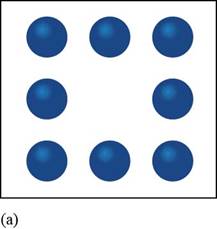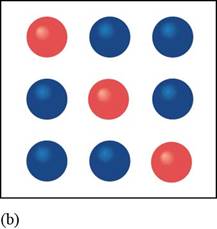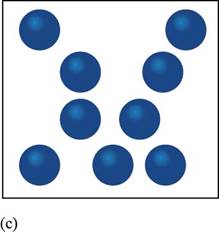
(a)
Interpretation: The diagrams analogous to crystalline solids and amorphous solids are to be predicted.
Concept introduction: The solids can be classified into two forms on the basis of the arrangement of their constituent particles. These forms of solid are,
- Crystalline solids
- Amorphous solids
In crystalline solids the constituent particles are arranged in an organized manner in their given space and the crystals of crystalline solids have definite geometry.
On other hand in amorphous solids the constituent particles are arranged in an unorganized manner that is all the constituent particles are arranged randomly in the space provided to them and do not have definite geometry.
To determine: The drawing given in the stated figure is to be classified as being analogous to a crystalline solid or an amorphous solid.
Answer to Problem 12.1VP
Solution
The given diagramof constituent particlesis analogous to a crystalline solid.
Explanation of Solution
Explanation
The given figure is,

Figure 1
In the given figure, the constituent particles are arranged in an organized specific manner in the space provided to them and have definite geometry.
Therefore, the given diagram of constituent particles is analogous to a crystalline solid.
(b)
To determine: The drawing given in the stated figure is to be classified as being analogous to a crystalline solid or an amorphous solid.
(b)
Answer to Problem 12.1VP
Solution
The given diagram of constituent particles is analogous to a crystalline solid.
Explanation of Solution
Explanation
In the given figure, the constituent particles are arranged in an organized specific manner in the space provided to them and have definite geometry

Figure
Therefore, the given diagram of constituent particles is analogous to a crystalline solid.
(c)
To determine: The drawing given in the stated figure is to be classified as being analogous to a crystalline solid or an amorphous solid..
(c)
Answer to Problem 12.1VP
Solution
The given diagram of constituent particles is analogous to an amorphous solid.
Explanation of Solution
Explanation
In the given figure, the constituent particles are not arranged in an organized manner in the space provided to them and do not have definite geometry

Figure
Therefore, the given diagram of constituent particles is analogous to an amorphous solid.
(d)
To determine: The drawing given in the stated figure is to be classified as being analogous to a crystalline solid or an amorphous solid..
(d)
Answer to Problem 12.1VP
Solution
The given diagram of constituted particles is analogous to an amorphous solid.
Explanation of Solution
Explanation
In the given figure, the constituent particles are not arranged in an organized manner in the space provided to them that is they are randomly arranged.

Figure
Therefore, the given diagram of constituted particles is analogous to an amorphous solid.
Conclusion
The conclusions are,
- a) The given diagram of constituent particles is analogous to a crystalline solid.
- b) The given diagram of constituent particles is analogous to a crystalline solid.
- c) The given diagram of constituent particles is analogous to an amorphous solid.
- d) The given diagram of constituent particles is analogous to an amorphous solid.
Want to see more full solutions like this?
Chapter 12 Solutions
Chemistry: The Science in Context (Fifth Edition)
- (12) Which one of the following statements about fluo- rometry is FALSE? a) Fluorescence is better detected at 90 from the exci- tation direction. b) Fluorescence is typically shifted to longer wave- length from the excitation wavelength. c) For most fluorescent compounds, radiation is pro- duced by a transitionarrow_forwardDon't used Ai solutionarrow_forwardDon't used Ai solutionarrow_forward
- Don't used Ai solutionarrow_forwardIndicate the correct option.a) Graphite conducts electricity, being an isotropic materialb) Graphite is not a conductor of electricityc) Both are falsearrow_forward(f) SO: Best Lewis Structure 3 e group geometry:_ shape/molecular geometry:, (g) CF2CF2 Best Lewis Structure polarity: e group arrangement:_ shape/molecular geometry: (h) (NH4)2SO4 Best Lewis Structure polarity: e group arrangement: shape/molecular geometry: polarity: Sketch (with angles): Sketch (with angles): Sketch (with angles):arrow_forward
- 1. Problem Set 3b Chem 141 For each of the following compounds draw the BEST Lewis Structure then sketch the molecule (showing bond angles). Identify (i) electron group geometry (ii) shape around EACH central atom (iii) whether the molecule is polar or non-polar (iv) (a) SeF4 Best Lewis Structure e group arrangement:_ shape/molecular geometry: polarity: (b) AsOBr3 Best Lewis Structure e group arrangement:_ shape/molecular geometry: polarity: Sketch (with angles): Sketch (with angles):arrow_forward(c) SOCI Best Lewis Structure 2 e group arrangement: shape/molecular geometry:_ (d) PCls Best Lewis Structure polarity: e group geometry:_ shape/molecular geometry:_ (e) Ba(BrO2): Best Lewis Structure polarity: e group arrangement: shape/molecular geometry: polarity: Sketch (with angles): Sketch (with angles): Sketch (with angles):arrow_forwardDon't used Ai solutionarrow_forward
 ChemistryChemistryISBN:9781305957404Author:Steven S. Zumdahl, Susan A. Zumdahl, Donald J. DeCostePublisher:Cengage Learning
ChemistryChemistryISBN:9781305957404Author:Steven S. Zumdahl, Susan A. Zumdahl, Donald J. DeCostePublisher:Cengage Learning ChemistryChemistryISBN:9781259911156Author:Raymond Chang Dr., Jason Overby ProfessorPublisher:McGraw-Hill Education
ChemistryChemistryISBN:9781259911156Author:Raymond Chang Dr., Jason Overby ProfessorPublisher:McGraw-Hill Education Principles of Instrumental AnalysisChemistryISBN:9781305577213Author:Douglas A. Skoog, F. James Holler, Stanley R. CrouchPublisher:Cengage Learning
Principles of Instrumental AnalysisChemistryISBN:9781305577213Author:Douglas A. Skoog, F. James Holler, Stanley R. CrouchPublisher:Cengage Learning Organic ChemistryChemistryISBN:9780078021558Author:Janice Gorzynski Smith Dr.Publisher:McGraw-Hill Education
Organic ChemistryChemistryISBN:9780078021558Author:Janice Gorzynski Smith Dr.Publisher:McGraw-Hill Education Chemistry: Principles and ReactionsChemistryISBN:9781305079373Author:William L. Masterton, Cecile N. HurleyPublisher:Cengage Learning
Chemistry: Principles and ReactionsChemistryISBN:9781305079373Author:William L. Masterton, Cecile N. HurleyPublisher:Cengage Learning Elementary Principles of Chemical Processes, Bind...ChemistryISBN:9781118431221Author:Richard M. Felder, Ronald W. Rousseau, Lisa G. BullardPublisher:WILEY
Elementary Principles of Chemical Processes, Bind...ChemistryISBN:9781118431221Author:Richard M. Felder, Ronald W. Rousseau, Lisa G. BullardPublisher:WILEY





